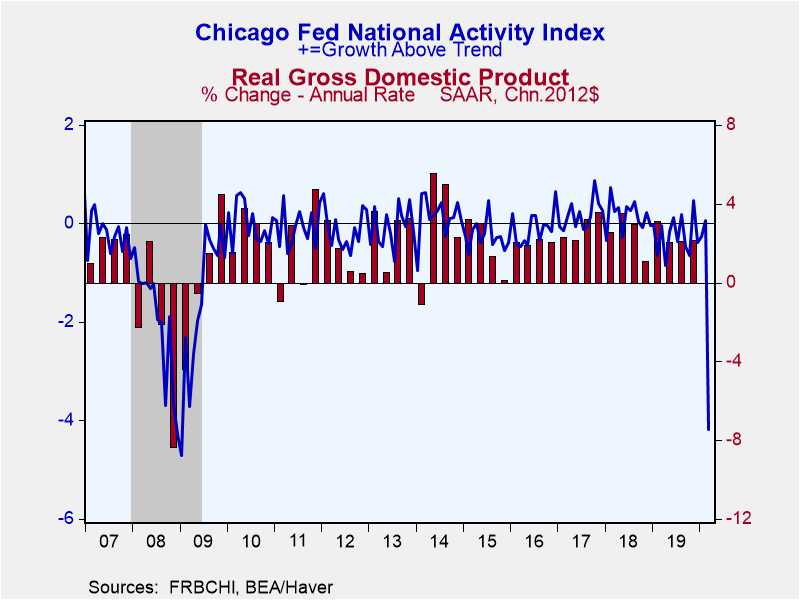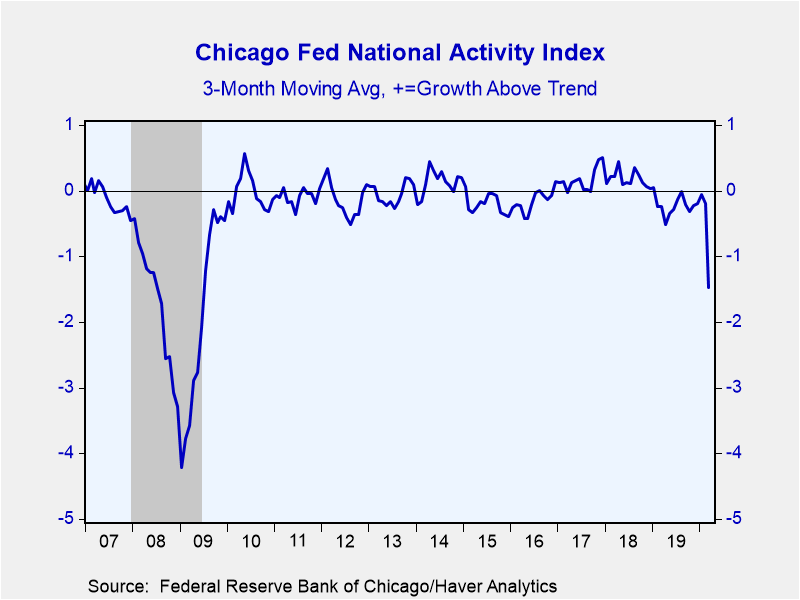 Global| Apr 20 2020
Global| Apr 20 2020Chicago Fed National Activity Index Signals Recession
by:Tom Moeller
|in:Economy in Brief
Summary
• The Federal Reserve Bank of Chicago indicated that the economy entered a downturn in the wake of the COVID-19 outbreak. The National Activity Index (CFNAI) declined to -4.19 during March from 0.06 in February, revised from 0.16. The [...]
• The Federal Reserve Bank of Chicago indicated that the economy entered a downturn in the wake of the COVID-19 outbreak.
The National Activity Index (CFNAI) declined to -4.19 during March from 0.06 in February, revised from 0.16. The three-month moving average of the index fell m/m to -1.47, its weakest level since June 2009. During the last 20 years, there has been a 71% correlation between the Chicago index and the q/q change in real GDP.
Each of the four component series of the index turned negative last month. The Production & Income series fell to a record low of -2.72. The Employment, Unemployment & Hours series declined to -1.23, the weakest reading since April 2009. The Personal Consumption & Housing gauge fell to -0.19, the lowest level since December 2018. The Sales, Orders and Inventories of -0.05 compared to -0.06 in February.
The diffusion index of the CFNAI, which measures the breadth of component change, fell sharply to -0.32, its lowest reading since May 2016.
The CFNAI is a weighted average of 85 monthly indicators of national economic activity. It is constructed to have an average value of zero and a standard deviation of one. Since economic activity tends toward trend growth rate over time, a positive index reading corresponds to growth above trend and a negative index reading corresponds to growth below trend.
These figures are available in Haver's SURVEYS database.
Do Stay-at-Home Orders Cause People to Stay at Home? Effects of Stay-at-Home Orders on Consumer Behavior from the Federal Reserve Bank of Chicago is available here.
| Federal Reserve Bank of Chicago | Mar | Feb | Jan | Mar '19 | 2019 | 2018 | 2017 |
|---|---|---|---|---|---|---|---|
| National Activity Index (+ = Growth Above Trend) | -4.19 | 0.06 | -0.27 | -0.04 | -0.23 | 0.15 | 0.17 |
| Production & Income | -2.72 | 0.06 | -0.30 | -0.03 | -0.16 | 0.10 | 0.09 |
| Employment, Unemployment & Hours | -1.23 | 0.07 | 0.04 | 0.02 | -0.01 | 0.10 | 0.07 |
| Personal Consumption & Housing | -0.19 | -0.02 | 0.03 | 0.02 | -0.03 | -0.06 | -0.05 |
| Sales, Orders & Inventories | -0.05 | -0.06 | 0.04 | -0.05 | -0.04 | 0.02 | 0.06 |
| 3-Month Moving Average | -1.47 | -0.20 | -0.06 | -0.24 | -- | -- | -- |
| Diffusion Index | -0.32 | -0.21 | -0.07 | -0.20 | -0.15 | 0.16 | 0.09 |
Tom Moeller
AuthorMore in Author Profile »Prior to joining Haver Analytics in 2000, Mr. Moeller worked as the Economist at Chancellor Capital Management from 1985 to 1999. There, he developed comprehensive economic forecasts and interpreted economic data for equity and fixed income portfolio managers. Also at Chancellor, Mr. Moeller worked as an equity analyst and was responsible for researching and rating companies in the economically sensitive automobile and housing industries for investment in Chancellor’s equity portfolio. Prior to joining Chancellor, Mr. Moeller was an Economist at Citibank from 1979 to 1984. He also analyzed pricing behavior in the metals industry for the Council on Wage and Price Stability in Washington, D.C. In 1999, Mr. Moeller received the award for most accurate forecast from the Forecasters' Club of New York. From 1990 to 1992 he was President of the New York Association for Business Economists. Mr. Moeller earned an M.B.A. in Finance from Fordham University, where he graduated in 1987. He holds a Bachelor of Arts in Economics from George Washington University.










